The CBSE Class 12 Physics previous year question paper is the best way to prepare for the upcoming physics board exam in 2024. Practicing the Physics previous year’s question paper gives students an idea about the types of questions that are asked in the board exam. As physics subject consists of a good amount of theory and numerical questions, it requires a good amount of practice to master the subject.
The best resource to master the physics subject for the board exam is to solve the previous year question paper 2024. Students who use the Physics Previous Year Question Paper from CBSE Class 12 might achieve exceptional results in their final exams. There is no doubt that the Class 12 aggregate has a significant influence on students’ professional paths and future decisions.
Physics Class 12 Previous Year Question Paper
The students appearing in CBSE Class 12 Exam 2023 must solve the Class 12 Physics Previous Year Question Paper given on this page to consolidate their preparation. We have given Class 12 Physics Previous Year Question Paper with solutions on this page so students will get an idea of answer framing in the main examination. Students solving Class 12 Physics Previous Year Question Paper always have the upper hand over those students who are not solving Class 12 Physics Previous Year Question Paper.
Solve all the Class 12 Physics Previous Year Question Paper given on your page and fetch some extra marks in the final board examination. Exam patterns and question kinds can be better understood by working through the Physics Class 12 Previous Years Question Papers from CBSE. Also, it dispels exam anxiety and provides students with the self-assurance they need to take the board exam.
Physics Previous Year Question Papers with Solutions Class 12- 2023
It’s never easy to study for the Class 12 Board exam, and we occasionally find it difficult to comprehend the format and marking scheme. Hence, it is vital to consistently retake the CBSE Previous Year’s Exam to comprehend the nature of questions asked and the marking scheme. The previous year question paper of the Class 12 Physics subject is given below for students with the answer solutions through the answer key.
CBSE Previous Year Question Papers Class 12 Physics PDF 2022
The CBSE class 12 previous year question paper of the CBSE class 12 Physics subject for the year 2022 is given below in the PDF form. Students must solve the question paper PDF to gain more marks in the exam.
CBSE Class 12 Physics Question Paper PDF 2022
Class 12 Physics Previous Year Question Paper with Solution Based on PDF – 2021
Question 1.
(a) Derive an expression for the induced
emf developed when a coil of N turns, and area of cross-section A, is rotated at a constant angular speed o in a uniform magnetic field B.
(b) A wheel with 100 metallic spokes each 0-5 m long is rotated with a speed of 120 rev/min in a plane normal to the horizontal component of the Earth’s magnetic field. If the resultant magnetic field at that place is 4 × 10-4 and the angle of dip at the place is 30°, find the emf induced between the axle and the rim of the wheel. [5]
OR
(a) Derive the expression for the magnetic energy stored in an inductor when a current I develops in it. Hence, obtain the expression for the magnetic energy density.
(b) A square loop of sides 5 cm carrying a current of 0-2 A in the clockwise direction is placed at a distance of 10 cm from an indefinitely long wire carrying a current of 1 A as shown. Calculate
(i) the resultant magnetic force, and
(ii) the torque, if any, active on the loop.
Answer:
(a) As the armature coil is rotated in the magnetic field, angle 0 between the field and normal to the coil changes continuously. Therefore, magnetic flux linked with the coil changes. An e.m.f. is induced in the coil. According to Fleming’s right hand rule, current induced in AB is from A to B and it is from C to D in CD in the external circuit current flows from B2 to B1.
To calculate the magnitude of e.m.f. induced:
Suppose,
A → Area of each turn of the coil
N → Number of turns in the coil
B → Strength of magnetic field
θ → Angle which normal to the coil makes
Magnetic flux linked with the coil in this position.
(a) Energy stored in an inductor : When a current flows through an inductor, a back e.m.f. is set up which opposes the growth of current. So, work needs to be done against back e.m.f. (e) in building up the current. This work done is stored as magnetic potential energy.
Let, I be the current through the inductor L at any instant t.
The forces acting on all sides of the square due to current of infinite length wire are lying in the plane of coil. Thus, there is no net torque. Thus torque is zero.
Question 2.
Explain, with the help of a diagram, how plane polarized light can be produced by scattering of light from the Sun.
Two polaroids P1 and P2 are placed with their pass axes perpendicular to each other. Unpolarised light of intensity I is incident on P1. A third polaroid P3 is kept between P1 and P2 such that its pass axis makes an angle of 45° with that of P1. Calculate the intensity of light transmitted P1, P2 and P3. [5]
OR
(a) Why cannot the phenomenon of interference be observed by illuminating two pin holes with two sodium lamps?
(b) Two monochromatic waves having displacements y1= a cos ωf and y2 = a cos (ωt + Φ ) from two coherent sources interfere to produce an interference pattern. Derive the expression for the resultant in¬tensity and obtain the conditions for constructive and destructive interference.
(c) Two wavelengths of sodium light of 590 nm and 596 nm are used in turn to study the diffraction taking place at a single slit of aperture 2 x 10-6 m. If the distance between the slit and the screen is 1.5 m, calculate the separation between the positions of the second maxima of diffraction pattern obtained in the two cases.
Answer:
Molecules behave like dipole radiators and scatter no energy along the dipole axis by this way plane polarized light can be produced during scattering of light.
(a) Phenomenon of interference can’t be observed by illuminating two pin holes with two sodium lamps because these sources are not coherent source (it means they are not in same phase).
(b) Consider two monochromatic coherent sources A and B with waves y1 = a cos ωt and y2 = a cos (ωt + Φ ) respectively.
Question 3.
(a) Describe briefly, with the help of a circuit
diagram, the method of measuring the internal resistance of a cell.
(b) Give reason why a potentiometer is preferred over a voltmeter for the measurement of emf of a cell.
(c) In the potentiometer circuit given below, calculate the balancing length l. Give reason, whether the circuit will work, if the driver cell of emf 5 V is replaced with a cell of 2 V, keeping all other factors constant. [5]
(a) State the working principle of a meter bridge used to measure an unknown resistance.
(b)Give reason.
(i) why the connections between the resistors in a meter bridge are made of thick copper strips.
(ii) why is it generally preferred to obtain the balance length near the mid-point of the bridge wire.
(c) Calculate the potential difference across the 4 Ω resistor in the given electrical circuit, using Kirchhoff’s rules.
Answer:
Where, r is the internal resistance of cell.
(b) Potentiometer is preferred over voltmeter for measurement of e.m.f. of cell because a voltmeter draws some current from the cell while potentiometer draws no current. Therefore, the potentionmeter measures the actual e.m.f. of cell whereas voltmeter measures the terminal voltage.
Hence, balancing will not possible as it needs to cater 300 mV.
OR
(a) Meter bridge is the practical apparatus which works on principle of Wheat-Stone bridge. It is used to measure unknown resistance experimentally.
(b) (i) Connection between resistors are made of thick copper strips so that it will have maximum resistance and location of point of balance (D) will be more accurate which results in correct measurement of unknown resistance.
(ii) It is preferred to obtain the balance length near the mid-point of the bridge wire because it increase the sensitivity of meter bridges.
(c) From KCL (Kirchhoff’s current law) at point D
Question 4.
A capacitor made of two parallel plates, each of area ‘A’ and separation W is charged by an external d.c.-source. Show that during charging, the displacement current inside the capacitor is the same as the current charging the capacitor. [2]
Answer:
From Ampere’s law,
∮Bdl=μ0i(t)
Let the case-1, where a point P is considered outside the capacitor charging.
From Ampere’s law magnetic field at point P will be :
Now, take case-2 where shape of surface under consideration covers capacitor’s plate as we consider there is no current through capacitor then this value of B will be zero.
Case-2
Hence, there is a contradiction.
Therefore, this Ampere’s law was modified with addition of displacement current inside capacitor.
Where, id is displacement current.
During charging of capacitor, outside the capacitor, ic (conduction current) flows and inside id (displacement current) flows.
Question 5.
A photon and a proton have the same deBroglie wavelength X. Prove that the energy of the photon is (2mλc/h) times the kinetic energy of the proton. [2]
Question 6.
A photon emitted during the de-excitation of electron from a state n the first excited state in a hydrogen atom, irradiates a metallic cathode of work function 2 eV, in a photo cell, with a stopping potential of 0.55V. Obtain the value of the quantum number of the state n. [2]
OR
A hydrogen atom in the ground state is excited by an electron beam 12-5 eV energy. Find out the maximum number of lines emitted by atom from its excited state.
Question 7.
Draw the ray diagram of an astronomical telescope showing image formation in the normal adjustment position. Write the expression for its magnifying power. [2]
OR
Draw a labelled ray diagram to show image formation by a compound microscope and write the expression for its resolving power.
Answer:
The magnifying power m is the ratio of the angle P subtended at the eye by the final image to the angle a which the object subtends at the lens or the eye. Hence,
Question 8.
Under which conditions can a rainbow be observed? Distinguish between a primary and a secondary rainbow. [2]
Answer :
The rainbow is an example of the dispersion of sunlight by the water drops in the atmosphere. This is a phenomenon due to combined effect of dispersion, refraction and reflection of Sunlight by spherical water droplets of rain. The conditions for observing a rainbow are that the Sun should be shining in one part of the sky (say near western horizontal while it is raining in the opposite part of the sky (say eastern horizon).
Difference between Primary and Secondary Rainbow:
| S.N. | Primary Rainbow | Secondary Rainbow |
| 1 | Three Step process (Refraction Reflection and Refraction). | Four Step process (Refraction-Reflection and Refraction) |
| 2 | Appearance intensity better than Secondary. | Appearance intensity lesser than Primary. |
| 3. | Single reflection occurs. | Double reflection occurs. |
| 4. | 2 Degree range occurs. | 3 Degree range. |
| 5. | Fig-1 | Fig-2 |
Question 9.
Explain the following : [2]
(a) Sky appears blue.
(b) The Sun appears reddish at
(i) sunset,
(ii) sunrise.
Answer:
(a) Light from the sun reaches the atmosphere that is comprised of the tiny particles of the atmosphere. These act as a prism and cause the different components to scatter. As blue light travels in shorter and smaller waves in comparison to the other colours of spectrum. It is scattered the most , causing the sky to appear bluish.
(b) The molecules of the atmosphere and other particles that are smaller than the longest wavelength of visible light are more effective in scattering light of shorter wavelengths than light of longer wavelengths. The amount of scattering is inversely proportional to the fourth power of the wavelength. (Rayleigh Effect) Light from the Sun near the horizon passes through a greater distance in the Earth’s atmosphere than does the light received when the Sun is overhead. The correspondingly greater scattering of short wavelengths accounts for the reddish appearance of the Sun at rising and at setting.
Question 10.
Draw equipotential surfaces for an electric dipole. [1]
Question 11.
A proton is accelerated through a potential difference V, subjected to a uniform magnetic field acting normal to the velocity of the proton. If the potential difference is doubled, how will the radius of the circular path described by the proton in the magnetic field change ? [1]
Answer:
Given, proton accelerated through potential difference V, the direction of magnetic field is normal to velocity of proton.
As we know
Question 12.
The magnetic susceptibility X of magnesium at 300 K is 1-2 × 105 . At what temperature will its magnetic susceptibility become 1-44 × 105 ? [1]
OR
The magnetic susceptibility X of a given material is – 0.5. Identify the magnetic material.
Question 13.
Identify the semiconductor diode whose V-I characteristics are as shown. [1]
Answer: Photo diode.
Question 14.
Which part of the electromagnetic spectrum is used in RADAR? Give its frequency range. [1]
OR
How are electromagnetic waves produced by accelerating charges ?
Answer : Microwaves [1GHz to 100 GHz].
OR
An oscillating electric field in space, produces an oscillating magnetic field, which in turn, is a source of oscillating electric field, and so on. The oscillating electric and magnetic fields thus regenerate each other.
Question 15.
A capacitor (C) and resistor (R) are connected in series with an ac source of voltage of frequency 50 Hz. The potential difference across C and R are respectively 120 V, 90 V, and the current in the circuit is 3 A. Calculate
(i) the impedance of the circuit
(ii) the value of the inductance, which when connected in series with C and R will make the power factor of the circuit unity. [3]
OR
The figure shows a series LCR circuit connected to a variable frequency 230 V source.
(a) Determine the source frequency which drives the circuit in resonance.
(b) Calculate the impedance of the circuit and amplitude of current at resonance.
(c) Show that potential drop across LC combination is zero at resonating frequency.
Answer:
(a) Source frequency will be same as resonance frequency of LC circuit,
(c) As at resonance frequency impedance of combination of L and C is 0.
Hence, voltage drop across LC combination is zero at resonating frequency.
Question 16
Give reason to explain why n and p regions of a Zener diode are heavily doped. Find the current through the Zener diode in the circuit given below : [3]
(Zener breakdown voltage is 15 V)
Answer :
By heavily doping both p and n sides of the junction, depletion region formed is very thin, i.e. < 106 m. Hence, electric field across the junction is very high (~5 × 106 V/m) even for a small reverse bias voltage. This can lead to a break down during reverse biasing.
Question 17.
Draw a labelled diagram of cyclotron. Explain its working principle. Show that cyclotron frequency is independent of the speed and radius of the orbit. [3]
OR
(a) Derive, with the help of a diagram, the expression for the magnetic field inside a very long solenoid having n turns per unit length carrying a current I.
(b) How is a toroid different from a solenoid?
Answer:
Cyclotron : Cyclotron is a device by which the positively charged particles like protons, deutrons, etc. can be accelerated.
Principle : Cyclotron works on the principle that a positively charged particle can be accelerated by making it to cross the same electric field repeatedly with the help of a magnetic field.
Construction : The construction of a simple cyclotron is shown in figure above, it consist of two-semi cylindrical boxes D1 and D2 , which are called Dees They are enclosed in an evacuated chamber.
Chamber is kept between the poles of a powerful magnet so that uniform magnetic field acts perpendicular to the plane of the dees. An alternating voltage is applied in the gap between the two dees by the help of a high frequency oscillator. The electric field is zero inside the dees.
Working and theory : At a certain instant, let D1 be positive and D2 be negative. A proton from an ion source will be accelerated towards D2 , it describes a semi-circular path with a constant speed and is acted upon only by the magnetic field. The radius of the circular path is given by.
From the above equation it follows that frequency f is independent of both v and r and is called cyclotron frequency. Also if we make the frequency of applied a.c. equal to f, then every time the proton reaches the gap between the dees, the direction of electric field is reversed and proton receives a push and finally it gains very high kinetic energy. The proton follows a spiral path and finally gets directed towards the target and comes out from it
OR
(a) Magnetic field inside the solenoid
(b) Toroid is a form in which a conductor is wound around a circular body. In this case we get magnetic field inside the core but poles are absent because circular body don’t have ends. Toroid is used in toroidal inductor, toroidal transformer.
Solenoid is a form in which conductor is wound around a cylindrical body with limb. In this case magnetic field creates two poles N and S. Solenoids have some flux leakage. This is used in relay, motors, electro-magnetes
Question 18
Prove that the magnetic moment of the electron revolving around a nucleus in an orbit of radius r with orbital speed v is equal to evr/2. Hence using Bohr’s postulate of quantization of angular momentum, deduce the expression for the magnetic moment of hydrogen atom in the ground state. [3]
Question 19.
Two large charged plane sheets of charge densities a and -2σ C/m2 are arranged vertically with a separation of d between them. Deduce expressions for the electric field at points
(i) to the left of the first sheet,
(ii) to the right of the second sheet, and
(iii) between the two sheets. [3]
OR
A spherical conducting shell of inner radius r1 and outer radius r2 has a charge Q.
(a) A charge q is placed at the center of the shell. Find out the surface charge density on the inner and outer surfaces of the shell.
(b) Is the electric field inside a cavity (with no charge) zero; independent of the fact whether the shell is spherical or not? Explain.
Question 20.
Draw a plot of a-particle scattering by a thin foil of gold to show the variation of the number of the scattered particles with scattering angle. Describe briefly how the large angle scattering explains the existence of the nucleus inside the atom, Explain with the help of impact parameter picture, how Rutherford scattering serves a powerful way to determine and upper limit on the size of the nucleus. [3]
Answer:
From the plot it is clear that Most of the a-particles passed through the foil,, only 0.14% of the incident a particles scatter by more than 1% and about 1 in 8000 deflect by more than 90° a-particles deflected backward due to strong repulsive force. This force will come from positive charge concentrated at the center as most of the particles get deflected by small angles.
The α-particles trajectory depends on collision’s impact parameter (b) for a given beam of a-particles, distribution of impact parameters as beam gets scattered in different directions with different probabilities.
fig.2 shows a-particle close to nucleus suffers large scattering. Impact parameter is minimum for head on collision a-particles rebound by 180°. Impact parameter is high, for undeviated a-particles. With deflection angle = 0°.
As these of nucleus was 10-14 m to 10-15 m w.r.t. 10-10 m size of an atom which is 10,000 to 100,000 times larger hence most of the space is empty, only small % of the incident particles rebound back indicates that number of α-particle goes head on collision. Hence most of the mass of the atom is concentrated in small volume. Thus, Rutherford scattering is a strong tool to determine upper limit to the size of the nucleus.
Question 21.
A 200 µF parallel plate capacitor having plate separation of 5 mm is charged by a 100 V dc source. It remains connected to the source. Using an insulated handle, the distance between the plates is doubled and a dielectric slab of thickness 5 mm and dielectric constant 10 is introduced between the plates. Explain with reason, how the
(i) capacitance,
(ii) electric field between the plates,
(iii) energy density of the capacitor will change ? [3]
Question 22.
Why is it difficult to detect the presence of an anti-neutrino during β -decay ? Define the term decay constant of a radioactive nucleus and derive the expression for its mean life in terms of the decay constant. [3]
OR
(a) State two distinguishing features of nuclear force.
(b) Draw a plot showing the variation of potential energy of a pair of nucleons as a function of their separation. Mark the regions on the graph where the force is
(i) attractive, and
(ii) repulsive.
Answer :
The symbols v and v present anti neutrino and neutrino respectively during j3 decay both are neutral particles. With very little or no mass. These particles are emitted from the nucleus along with the electron or positron during the decay process. Neutrions interact very weakly with matter, they can even penetrate the earth without being absorbed. It is for this reason that their detection is extremely difficult and their presence went unnoticed for long.
Decay constant:
Decay constant of a radioactive element is the reciprocal of time during which the number of atoms left in the sample reduces to 1/r times the number of atoms in the original sample.
Derivation of mean life :
Let us consider, No be the total number of radioactive atoms present initially. After time t, total no. of atoms present (undecayed) be N. In further dt time dN be the no. of atoms disintegrated. So, the life of dN atoms ranges lies between t + dt and dt. Since, dt is very small time, the most appropriate life of dN atom is t. So the total life of N atom = f.dN
Now, substituting the value of dN and changing the limit in equation (i) from (ii) we get
This expression gives the relation between mean life and decay constant. Hence, mean life is reciprocal of decay constant.
OR
(a) Distinguish features of nuclear force are :
(i) Nuclear forces are very strong binding forces (attractive force.)
(ii) It is independent of the charges protons and neutrons (charge independent.)
(iii) It depends on the spins of the nucleons.
(b) Plot showing variation of potential energy of a pair of nucleons as a function of separation mark attractive and repulsive region.
X-axis shows separation between pair of nucleons and Y-axis shows variation of potential energy w.r.t. separation
(in x 10-15 m).
Question 23.
A triangular prism of refracting angle 60° is made of a transparent material of refractive index 2/√3. A ray of light is incident normally on the face KL as shown in the figure. Trace the path of the ray as it passes through the prism and calculate the angle of emergence and angle of deviation. [3]
Answer:
From diagram it is clear that incidence angle at face KM is 60°.
Hence, critical angle is also 60°.
Therefore, incident light ray will not emerge from KM face due to total internal reflection at this face. Hence, it will move along face KM Angle of emergence = 90°.
Hence angle of deviation = 30° (from fig.)
Question 24.
Show, on a plot, variation of resistivity of
(i) a conductor, and
(ii) a typical semiconductor as a function of temperature.
Using the expression for the resistivity in . terms of number density and relaxation time between the collisions, explain how resistivity in the case of a conductor increases while it decreases in a semiconductor, with the rise of temperature. [3]
Answer:
n → number of free electrons
t → Average time between collisions.
In metals n is not dependent on temperature to any appreciable extent and thus the decrease in the value of x with rise in temperature causes p to increases. for semiconductors, n increases with temperature. This increases more than compensates any decrease in t, so that for such materials, p decreases with temperature.
Class 12 Physics Previous Year Question Paper with Solution Based on CBSE PDF – 2020
Question 1.
Two electric bulbs P and Q have their resistances in the ratio of 1 : 2. They are connected in series across a battery. Find the ratio of the power dissipation in these bulbs. [2]
Answer :
Let resistances of bulbs P and Q be R and 2R respectively. As they are connected in series, so current through each bulb is same. Let the current be I.

Question 2.
A10 V cell of negligible internal resistance is connected in parallel across a battery of emf 200 V and internal resistance 38 Q as shown in the figure. Find the value of current in the circuit. [2]
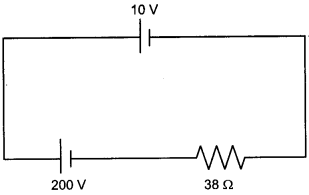
OR
In a potentiometer arrangement for deter-mining the emf of a cell, the balance point of the cell in open circuit is 350 cm. When a resistance of 9 Q is used in the external circuit of the cell, the balance point shifts to 300 cm. Determine the internal resistance of the cell.
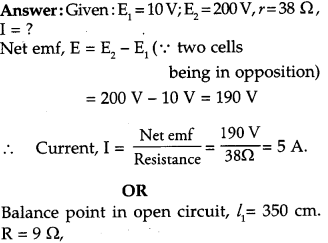
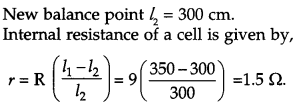
Question 3.
(a) Why are infra-red waves often called heat waves ? Explain.
(b) What do you understand by the statement, “Electromagnetic waves trans-port momentum” ? [1]
Answer:
(a) Infra-red waves are called heat waves because they raise the temperature of the object on which they fall and hence increase their thermal motion. They also affect the photographic plate and are readily absorbed by most of the materials.
(b) Electromagnetic waves transport momentum. This means that when an electromagnetic wave travels through space with energy U and speed c, then it transports linear momentum p = U/C. If a surface absorbs the waves completely, then momentum ‘p’ is delivered to the surface. If the surface reflects the wave, then momentum delivered by both incident and reflected wave adds on to give ‘2p’ momentum.
Question 4.
If light of wavelength 412.5 nm is incident on each of the metals given below, which ones will show photoelectric emission and why? [2]
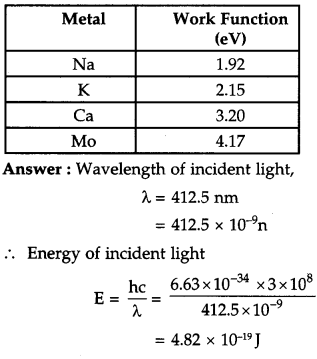

Since, the energy of incident radiation is greater than the work function of sodium and potassium, but less than that of calcium and molybdenum, therefore, photoelectric emission will take place in sodium and potassium.
Question 5.
A carrier wave of peak voltage 15 V is used to transmit a message signal. Find the peak voltage of the modulating signal in order to have a modulation index of 60%. [2]
Question 6.
The teachers of Geeta’s school took the students on a study trip to a power generating station, located nearly 200 km away from the city. The teacher explained that electrical energy is transmitted over such a long distance to their city, in the form of alternating current (ac) raised to a high voltage. At the receiving end in the city, the voltage is reduced to operate the devices. As a result, the power loss is reduced. Geeta listened to the teacher and asked questions about how the ac is converted to a higher or lower voltage. [4]
(a) Name the device used to change the alternating voltage to a higher or lower value. State one cause for power dissipation in this device.
(b) Explain with an example, how power loss is reduced if the energy is transmitted over long distances as an alternating current rather than a direct current.
(c) Write two values each shown by the teachers and Geeta.
Answer :
(a) The device used to change alternating voltage to a higher or lower value is a transformer.
Causes of power dissipation in this device are :
1. Core losses due to eddy currents and hysteresis loop due to alternating flux.
2. Copper losses due to resistance of winding in primary and secondary coils.
3. Loss of power due to leakage of magnetic flux in coil.
(b) The loss of power in the transmission lines is I2R, where I is the strength of current and R is the resistance of the wires. To reduce the power loss a.c. is transmitted over long distances at extremely high voltages. This reduces I in the same ratio. Therefore, I2R becomes negligibly low. For the same reason, at the generating stations, the voltage is stepped up to transmit it over long distances to minimize power loss. Therefore a.c. is used because stepping up is not possible for direct current.
Question 7.
(a) Define electric flux. Is it a scalar or a vector quantity ? A point charge q is at a distance of dl2 directly above the center of a square of side d, as shown in the figure. Use Gauss’ law to obtain the expression for the electric flux through the square.
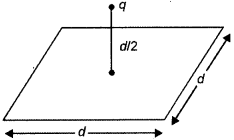
(b) If the point charge is now moved to a distance ‘d ‘ from the center of the square and the side of the square is doubled, explain how the electric flux will be affected. [5]
OR
(a) Use Gauss’ law to derive the expression for the electric field (E) due to a straight uniformly charged infinite line of charge density λ C/m.
(b) Draw a graph to show the variation of E with perpendicular distance r from the line of charge.
(c) Find the work done in bringing a charge q from perpendicular distance r1to r2( r2> r1).
Answer:
(a) Electric flux : Electric flux through an area is defined as the product of electric field strength E and area dS perpendicular to the field. It represents the field lines crossing the area. It is a scalar quantity. Imagine a cube of edge d, enclosing the charge. The square surface is one of the six faces of this cube. According to Gauss’ theorem in electrostatics,
Total electric flux through the cube = qε0
This is the total flux through all six surtace
∴ Electric flux through the square surface = qσε0
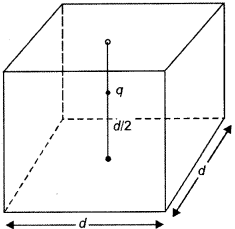
(b) On moving the charge to distance d from the center of square and making side of square 2d, does not change the flux at all because flux is independent of side of square or distance of charge in this case.
OR
(a) Electric field E→ due to a straight uniformly charged infinite line of charge density λ : Consider a cylindrical Gaussian surface of radius r and length l coaxial with line charge. The cylindrical Gaussian surface may be divided into three parts :
(i) curved surface S1
(ii) flat surface S2 and
(iii) flat surface S3.
By symmetry, the electric field has the same magnitude E at each point of curved surface Sj and is directed radially outward. We consider small elements of surfaces S1, S2 and S3.
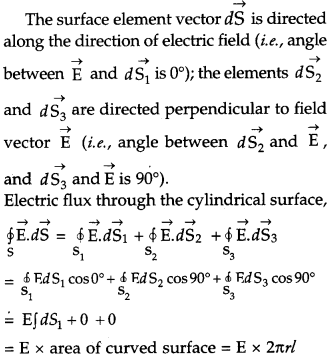
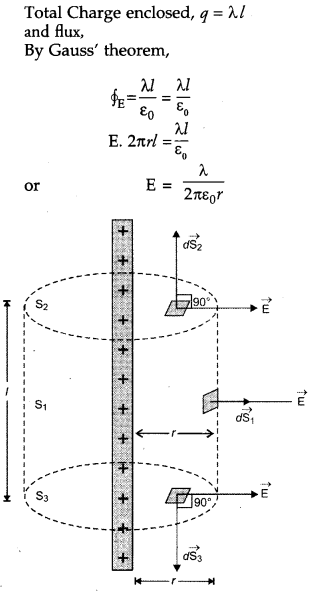
b) Graph showing variation of E with perpendicular distance from line of charge : The electric field is inversely proportional to distance V from line of charge.
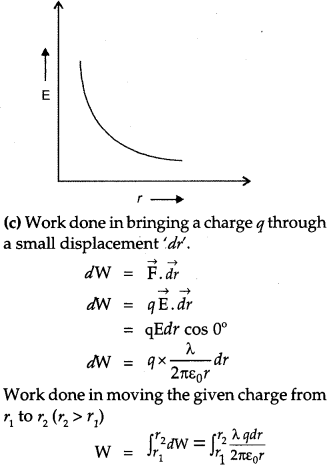
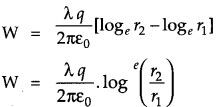
Question 8
(a) State the principle of an ac generator and explain its working with the help of a labelled diagram. Obtain the expression for the emf induced in a coil having N turns each of cross-sectional area A, rotating with a constant angular speed ω in a magnetic field B→ , directed perpendicular to the axis of rotation.
(b) An aeroplane is flying horizontally from west to east with a velocity of 900 km/ hour. Calculate the potential difference developed between the ends of its wings having a span of 20 m. The horizontal component of the Earth’s magnetic field is 5 × 10-4 T and the angle of dip is 30°. [5]
OR
A device X is connected across an ac source of voltage V = V0 sin ωt . The current through X is given as I = I0 sin (ωt+π2)
(a) Identify the device X and write the expression for its reactance.
(b) Draw graphs showing variation of voltage and current with time over one cycle of ac, for X.
(c) How does the reactance of the device X vary with frequency of the ac ? Show this variation graphically.
(d) Draw the phasor diagram for the device X.
Answer :
(a) Principle of ac generator :
The ac generator is based on the principle of electromagnetic induction. When closed coil is rotated in a uniform field with its axis perpendicular to field, then magnetic flux changes and emf is induced.
Working :
When the armature coil rotates, the magnetic flux linked with it changes and produces induced current. If initially, coil PQRS is in vertical position and rotated clockwise, then PQ moves down and SR moves up. By Fleming’s right hand rule, induced current flows from Q to P and S to R which is the first half rotation of coil. Brush B1 is positive terminal and B2is negative. In second half rotation, PQ moves up and SR moves down. So induced current reverses and the alternating current is produced in this manner by the generator.
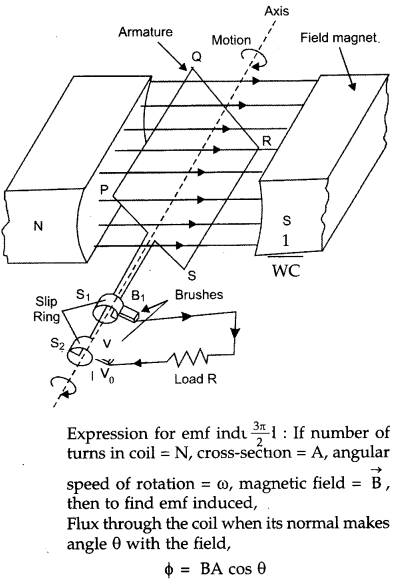
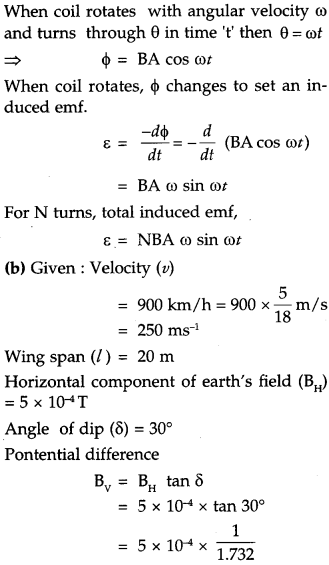
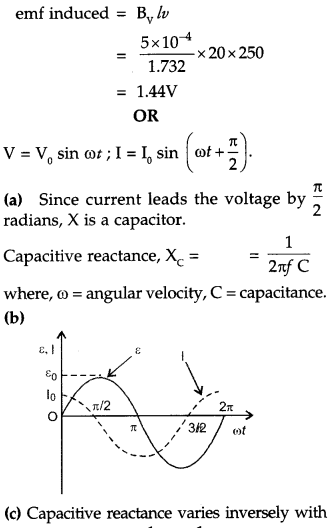
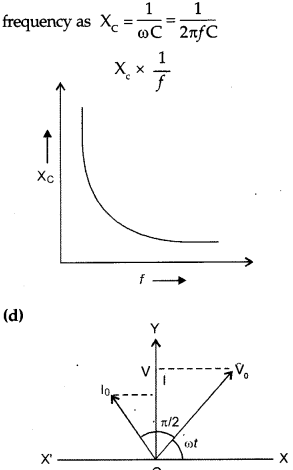
Question 9.
(a) Draw a ray diagram to show image formation when the concave mirror produces a real, inverted and magnified image of the object.
(b) Obtain the mirror formula and write the expression for the linear magnification.
(c) Explain two advantages of a reflecting telescope over a refracting telescope. [5]
OR
(a) Define a wave front. Using Huygens’ principle, verify the laws of reflection at a plane surface.
(b) In a single slit diffraction experiment, the width of the slit is made double the original width. How does this affect the size and intensity of the central diffraction band ? Explain.
(c) When a tiny circular obstacle is placed in the path of light from a distant source, a bright spot is seen at the center of the obstacle. Explain why ?
Answer :
(a) Concave mirror produces real, inverted and magnified image for object placed between F and C :
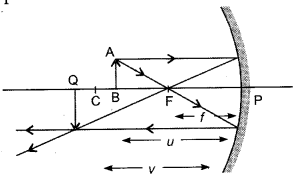
(b) Derivation for mirror formula and magnification: Consider an object AB be placed in front of a concave mirror beyond center of curvature C.
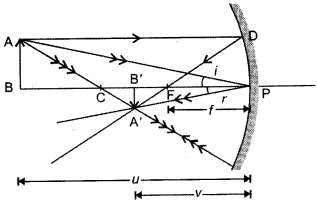
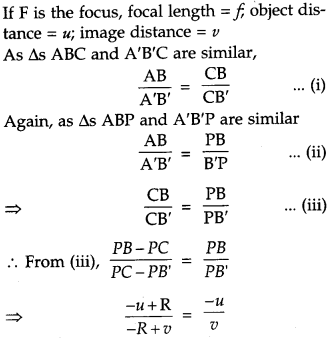
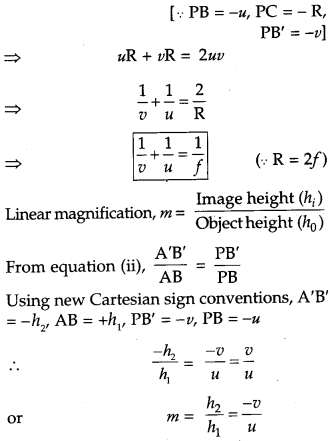
(c) Advantages of reflecting telescope over a refracting telescope are :
1. Reflecting telescope is free from chromatic and spherical aberrations unlike refracting telescope. Thus image formed is sharp and bright.
2. It has a larger light gathering power so that a bright image of even far off object is obtained.
3. Resolving power of reflecting telescope is large.
OR
(a) Wave front is defined as the continuous locus of all the particles of a medium which are vibrating in the same phase. Verification of laws of reflection using Huygens’s principle : Let XY be a reflecting surface at which a wave front is being incident obliquely. Let v be the speed of the wave front and at time t = 0, the wave front touches the surface XY at A. After time t, point B of wave front reaches the point B’ of the surface.
According to Huygens’s principle each point of wave front acts as a source of secondary waves. When the point A of wave front strikes the reflecting surface, then due to presence of reflecting surface, it cannot advance further; but the secondary wavelet originating from point A begins to spread in all directions in the first medium with speed v. As the wave front AB advances further, its points A1, A2, A3 etc. strike the reflecting surface successively and send spherical secondary wavelets in the first medium.
Question 10.
A proton and an electron travelling along parallel paths enter a region of uniform magnetic field, acting perpendicular to their paths. Which of them will move in a circular path with higher frequency ? [1]
Answer:
Frequency of revolution of a particle

OR
Since mass of electron is less than that of proton, therefore, its frequency of revolution will be higher than that of proton
Question 11.
Name the electromagnetic radiations used for
(a) water purification, and
(b) eye surgery. [1]
Answer:
(a) Water purification : Ultraviolet radiation.
(b) Eye surgery : Ultraviolet radiation/laser
Question 12.
Draw graphs showing variation of photoelectric current with applied voltage for two incident radiations of equal frequency and different intensities. Mark the graph for the radiation of higher intensity. [1]
Answer :
Graph for photoelectric current (I) versus applied potential for radiations of same frequency and varying intensity.
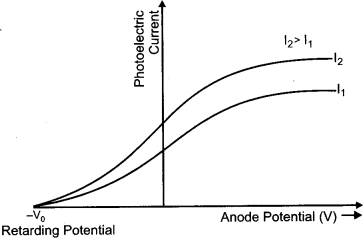
Question 13.
Four nuclei of an element undergo fusion to form a heavier nucleus, with release of energy. Which of the two the parent or the daughter nucleus would have higher binding energy per nucleon ? [1]
Answer:
When lighter nuclei combine to form a heavier nucleus, binding energy per nucleon increases and energy is released. Thus, the daughter nucleus would have higher binding energy per nucleon.
Question 14.
Which mode of propagation is used by short wave broadcast services [1]
Question 15.
Four point charges Q, q, Q and q are placed at the corners of a square of side ‘a’ as shown in the figure.
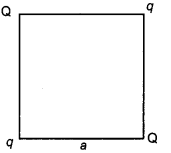
Find the
(a) resultant electric force on a charge Q and
(b) potential energy of this system. [3]
R
(a) Three point charges q – 4q and 2q are placed at the vertices of an equilateral triangle ABC of side ‘l’ as shown in the figure. Obtain the expression for the magnitude of the resultant electric force acting on the charge q.
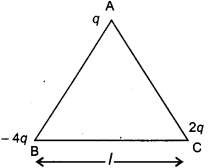
b) Find out the amount of the work done to separate the charges at infinite distance.
Answer :
(a) Force on charge Q at B due to charge q at A
![]()
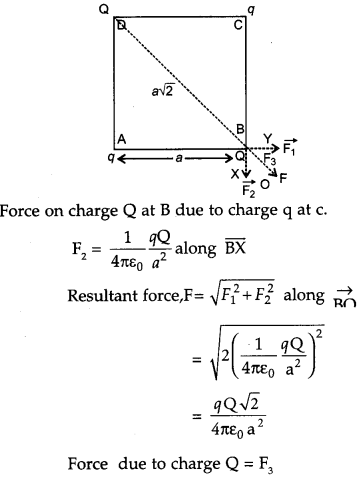
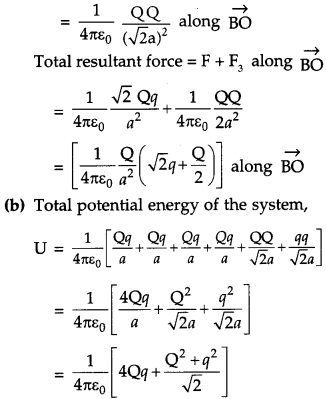
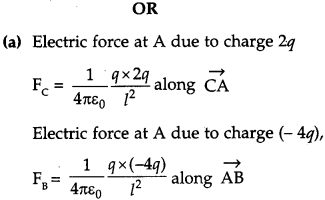
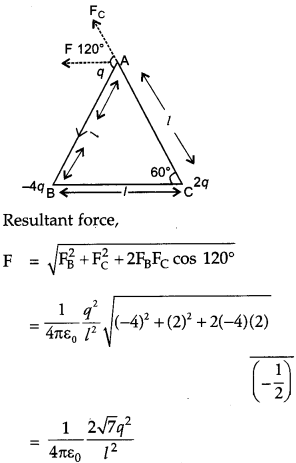
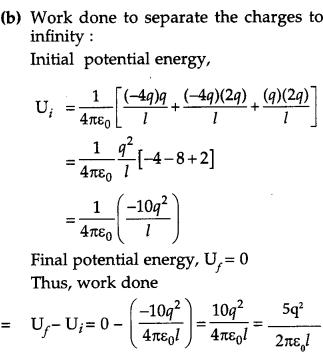
Question 16.
(a) Define the term ‘conductivity’ of a metallic wire. Write its SI unit.
(b) Using the concept of free electrons in a conductor, derive the expression for the conductivity of a wire in terms of number density and relaxation time. Hence obtain the relation between current density and the applied electric field E.
Answer:
(a) Conductivity of a metallic wire is defined as its ability to allow electric charges or heat to pass through it. Numerically, conductivity of a material is reciprocal of its resistivity.
SI unit : ohm-1 m-1 or mho m-1 or Siemen m-1
(b) Consider a potential difference V be applied across a conductor of length l and cross section A.
Electric field inside the conductor, E = v/l.
Due to the external field the free electrons inside the conductor drift with velocity Vd.
Let, number of electrons per unit volume = n,
charge on an electron = e
Total electrons in length, l = nAl And,
total charge, q = neAl
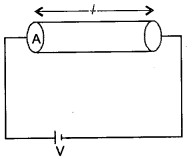
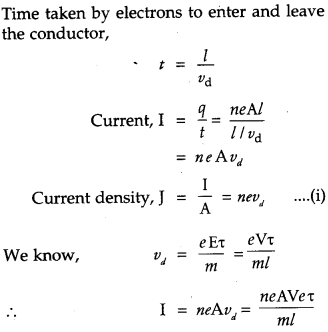
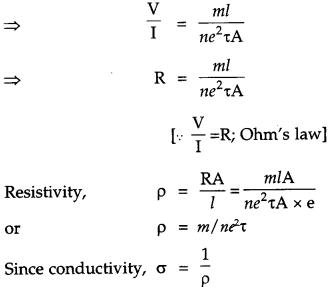
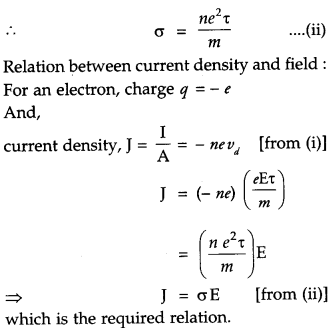
Question 17.
A bar magnet of magnetic moment 6 J/T is aligned at 60° with a uniform external magnetic field of 0.44 T. Calculate
(a) the work done in turning the magnet to align its magnetic moment
(i) normal to the magnetic field,
(ii) opposite to the magnetic field, and
(b) the torque on the magnet in the final orientation in case (ii). [3]
Answer:
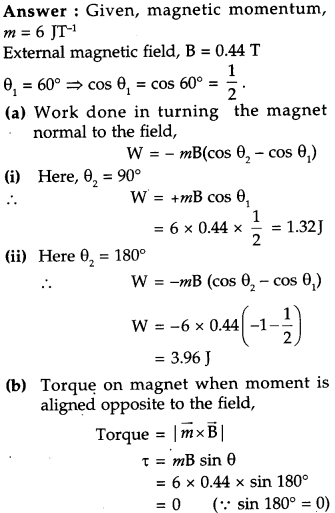
Question 18.
(a) An iron ring of relative permeability μ has winding’s of insulated copper wire of n turns per meter. When the current in the winding’s is I, find the expression for the magnetic field in the ring.
(b) The susceptibility of a magnetic material is 0.9853. Identify the type of magnetic material. Draw the modification of the field pattern on keeping a piece of this material in a uniform magnetic field. [3]
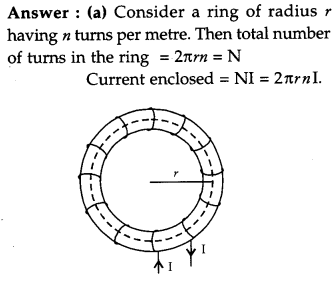
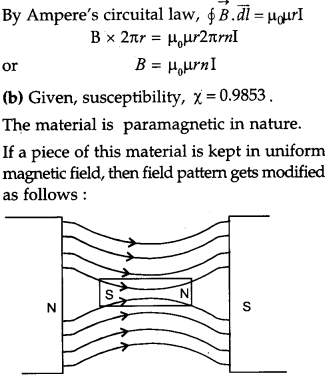
Question 19.
(a) Show using a proper diagram how unpolarised light can be linearly polarised by reflection from a transparent glass surface.
(b) The figure shows a ray of light falling normally on the face AB of an equilateral glass prism having refractive index 3/2
placed in water of refractive index 4/3 Will this ray suffer total internal reflection on striking the face AC ?
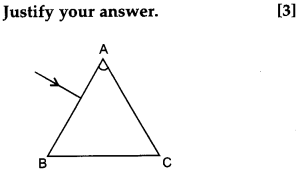
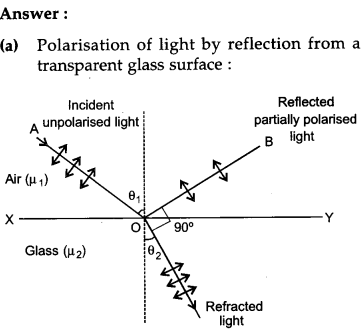
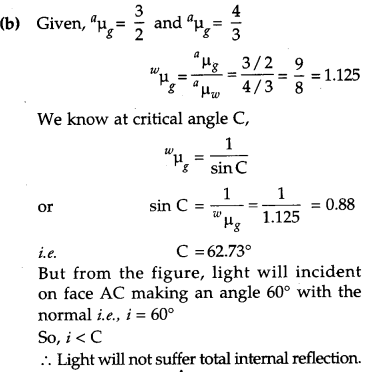
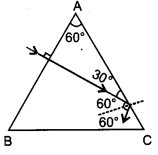
Question 20.
(a) If one of two identical slits producing interference in Young’s experiment is covered with glass, so that the light intensity passing through it is reduced to 50%, find the ratio of the maximum and minimum intensity of the fringe in the interference pattern.
(b) What kind of fringes do you expect to observe if white light is used instead of monochromatic light ? [3]
Answer :
(a) The resultant intensity in Young’s experiment is given by
![]()
When slit is not covered, then I0 is the intensity from each slit.
Maximum intensity (Imax) occurs when Φ = 0°.
Minimum intensity (Imin) occurs when (Φ ) = 180°.
If one slit is covered with glass to reduce its intensity by 50%, then
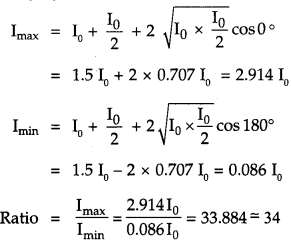
(b) If instead of monochromatic light, white light is used, then the central fringe will be white and the fringes on either side will be coloured. Blue colour will be nearer to central fringe and red will be farther away. The path difference at the centre on perpen¬dicular bisector of slits will be zero for all colours and each colour produces a bright fringe thus resulting in white fringe. Further, the shortest visible wave, blue, produces a bright fringe first.
Question 21.
A symmetric biconvex lens of radius of curvature R and made of glass of refractive index 1.5, is placed on a layer of liquid placed on top of a plane mirror as shown in the figure. An optical needle with its tip on the principal axis of the lens is moved along the axis until its real, inverted image coincides with the needle itself. The distance of the needle from the lens is measured to be x. On removing the liquid layer and repeating the experiment, the distance is found to be y. Obtain the expression for the refractive index of the liquid in terms of x and y. [3]
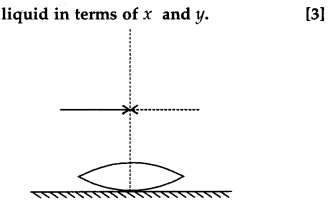
Answer:
Given, refractive index of lens, μg = 1.5. The distance of the needle from the lens in the first case = The focal length of the combination of convex lens and planoconcave lens formed by the liquid, f= x And, the distance measured in the second case = Focal length of the convex lens, f1 = y If the focal length of planoconcave lens formed by the liquid be f2, then
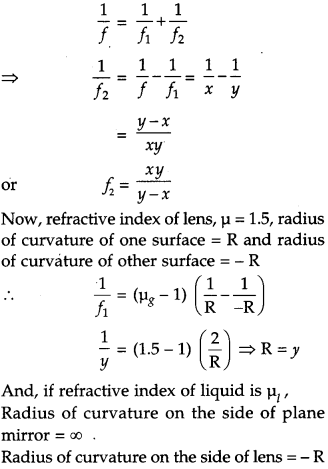
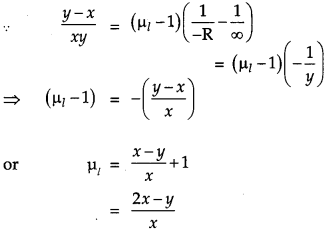
Question 22.
(a) State Bohr’s postulate to define stable- orbits in hydrogen atom. How does de Broglie’s hypothesis explain the stability of these orbits ?
(b) A hydrogen atom initially in the ground state absorbs a photon which excites it to the n = 4 level. Estimate the frequency of the photon. [3]
Answer :
(a) Bohr’s postulate for stable orbits in hydrogen atom : An electron can revolve only in those circular orbits in which its angular momentum is an integral multiple of h/2π, where h is Planck’s constant.
If n is the principal quantum number of orbit, then an electron can revolve only in . certain orbits or definite radii. These are called stable orbits.
de Broglie explanation of stability of orbits:
According to de Broglie, orbiting electron around the nucleus is associated with a stationary wave. Electron wave is a circular standing wave. Since destructive interference will occur if a standing wave does not close upon itself, only those de Broglie waves exist for which the circumference of . circular orbit contains a whole number of wavelengths i.e., for orbit circumference of nth orbit as 2nπrn
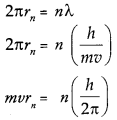
OR
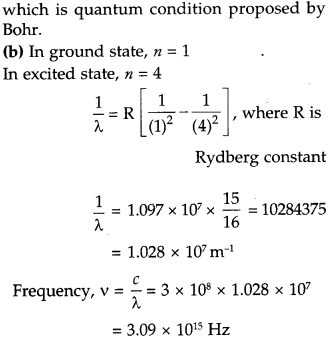
Question 23.
(a) Explain the processes of nuclear fission and nuclear fusion by using the plot of binding energy per nucleon (BE/A) versus the mass number A.
(b) A radioactive isotope has a half-life of 10 years. How long will it take for the activity to reduce to 3.125% ? [3]
Answer:
(a) Plot of binding energy per nucleon mass number :
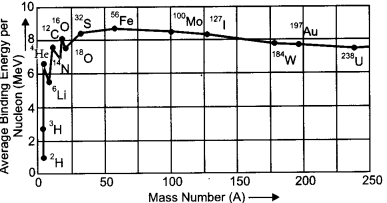
1. When we move from the heavy nuclei region to the middle region of the plot, we find that there will be a gain in the overall binding energy and hence results in release of energy. This indicates that energy can be released when a heavy nucleus (A ~ 240) breaks into two roughly equal fragments. This process is called nuclear fission.
2. Similarly, when we move from lighter nuclei to heavier nuclei, we again find that there will be gain in the overall binding energy and hence release of energy takes place. This indicates that energy can be released when two or more lighter nuclei fuse together to form a heavy nucleus. This process is called nuclear fusion.
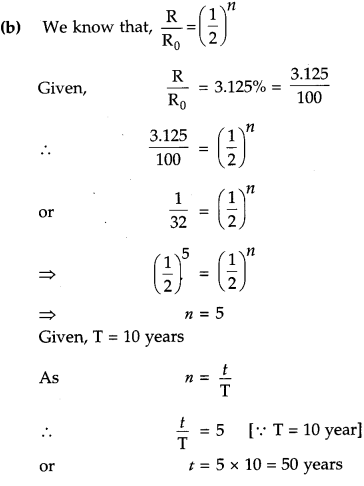
Question 24.
(a) A student wants to use two p-n junction diodes to convert alternating current into direct current. Draw the labelled circuit diagram she would use and explain how it works.
(b) Give the truth table and circuit symbol for NAND gate. [3]
Answer :
(a) Full wave rectifier :
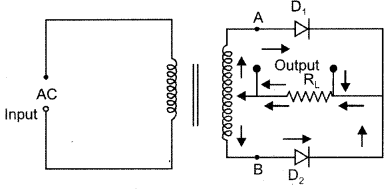
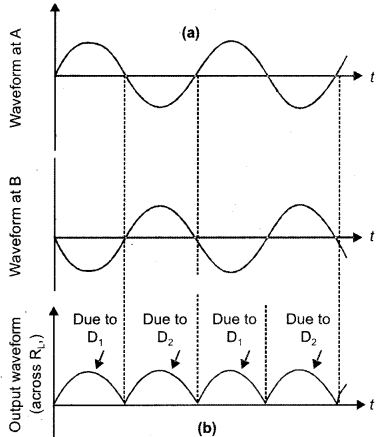
Explanation : In positive half cycle of AC, end A becomes positive and D1 becomes forward biased and D2 is reverse biased, so conducts and D2 doesn’t. So conventional current flows through D1, RL and upper half of secondary winding. Similarly, during negative half cycle of AC, diode D2 becomes forward biased and D1 is reverse biased, current flows through D2, RL and lower half of secondary winding. Thus, current flows in same direction in both half cycles of input AC voltage.
Question 25.
Draw the typical input and output characteristics of an n-p-n transistor in CE configuration. Show how these characteristics can be used to determine (a) the input resistance (r ), and (b) current amplification factor (β). [3]
Question 26.
(a) Give three reasons why modulation of a message signal is necessary for long distance transmission.
(b) Show graphically an audio signal, a carrier wave and an amplitude modulated wave. [3]
Class 12 Physics Previous Year Question Paper with Solution Based on CBSE PDF – 2019
Question 1.
Draw the intensity pattern for single slit diffraction and double slit interference. Hence, state two differences between interference and diffraction patterns. [2]
OR
Unpolarised light is passed through a polaroid P1 When this polarised beam passes through another polaroid P2 and if the pass axis of P2 makes angle 6 with the pass axis of P2 , then write the expression for the polarised beam passing through P2 . Draw a plot showing the variation of intensity when 9 varies from 0 to 2π.
Answer:
Intensity pattern for single slit diffraction:
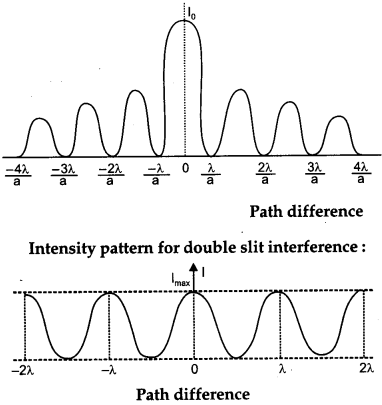
Difference between interference and diffraction patterns:
(a) Interference fringes are of the same width while diffraction fringes are not of the same width.
(b) In interference pattern all bright bands are of same intensity while in diffraction pattern all bright bands are not of same intensity.
OR
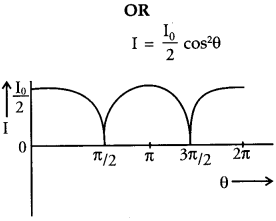
Question 2.
Identify the electromagnetic waves whose wavelengths vary as
(a) 10-12 m < λ < 10-8 m
(b) 10-3 m < λ < 10-1 m
Write one use for each. [2]
Answer:
(a) X – rays → To detect fractures in the human body.
(b) Microwaves → For aircraft navigation in RADAR systems.
Question 3.
Find the condition under which the charged particles moving with different speeds in the presence of electric and magnetic field vectors can be used to select charged particles of a particular speed. [2]
Answer :
(a) The velocity v⃗ of the charged particles, and the E⃗ and B⃗ vectors, should be mutually perpendicular. Also the forces on q, due to E⃗ and B⃗ , must be oppositely directed.
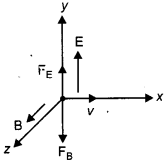
(b) If magnetic force = electrostatic force

Question 4.
A 12.5 eV electron beam is used to excite a gaseous hydrogen atom at room temperature. Determine the wavelengths and the corresponding series of the lines emitted. [2]
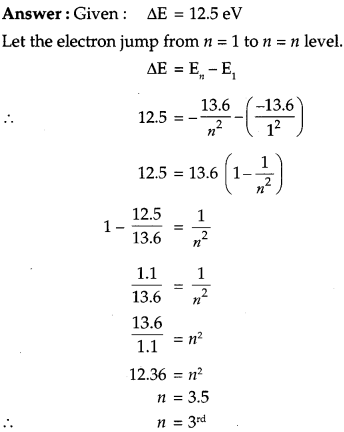
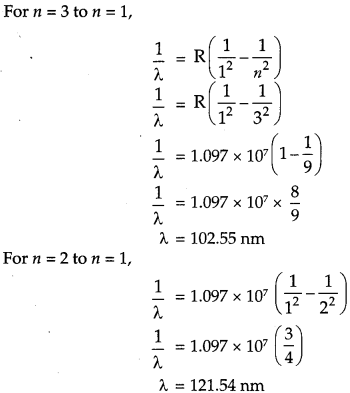
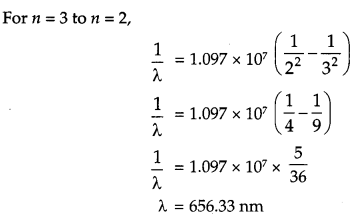
Hence, λ = 102.5 nm and 121.5 nm → Lyman series and λ = 656.33 nm → Balmer series
Question 5.
Write two properties of a material suitable for making
(a) a permanent magnet, and
(b) an electromagnet. [2]
Answer :
Properties of a material suitable for making permanent magnet:
- High retentivity.
- High coercivity.
Properties of a material suitable for making electromagnet:
- High permeability.
- Low retentivity.
Question 6.
Asha’s mother read an article in the newspaper about a disaster that took place at Chernobyl. She could not understand much from the article and asked a few questions from Asha regarding the article. Asha tried to answer her mother’s questions based on what she learnt in Class XII Physics. [4]
(a) What was the installation at Chernobyl where the disaster took place ? What, according to you, was the cause of this disaster ?
(b) Explain the process of release of energy in the installation at Chernobyl.
(c) What, according to you, were the values displayed by Asha and her mother ?
Answer :
(a) Nuclear power plant was installed at Chernobyl where the disaster took place. The causes of this disaster are deficiencies in the reactor design and in operating regulations.
(b) Nuclear fission.
7. (a) Derive an expression for the electric field E due to a dipole of length ‘2a’ at a point distant r from the center of the dipole on the axial line.
(b) Draw a graph of E versus r for r >> a.
(c) If this dipole were kept in a uniform external electric field E0 diagrammatically represent the position of the dipole in stable and unstable equilibrium and write the expressions for the torque acting on the dipole in both the cases. [5]
OR
(a) Use Gauss’s theorem to find the electric field due to a uniformly charged infinitely large plane thin sheet with surface charge density σ.
(b) An infinitely large thin plane sheet has a uniform surface charge density + σ. Obtain the expression for the amount of work done in bringing a point charge q from infinity to a point, distant r, in front of the charged plane sheet.
Answer :
(a) Consider an electric dipole AB. The charges -q and +q of dipole are situated at A and B respectively, as shown in the figure. The separation between the charges is 2a. Electric dipole moment is given by
p = q . 2a …(i)
Consider a point P on the axis of dipole at a distance r from mid point O of electric dipole. The distance of point P from charge +q at B is,
BP = r-a
and distance of point P from charge -q at A is,
AP = r + a Let E1 and E2 be the electric field strengths at point P due to charges +q and -q respectively.
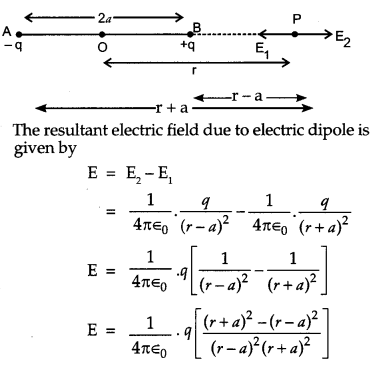
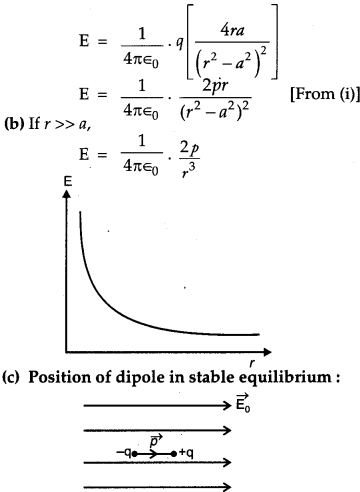
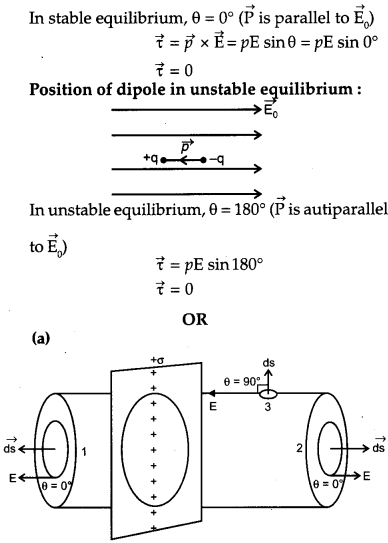
Let electric charge be uniformly distributed over the surface of a thin non-conducting infinite sheet. Let the surface charge density be σ.
According to Gauss theorem:
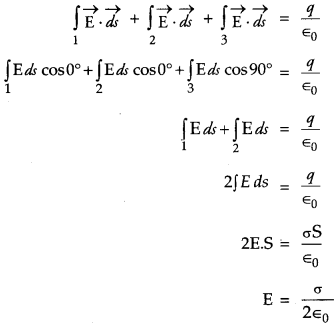
(b) The electric field due to a uniformly charged infinitely large thin sheet with surface charge density σ is,
E=σ2ϵ0 ……… (i)
The amount of work done in bringing a point charge q from infinity to a point, at a distance r is given by
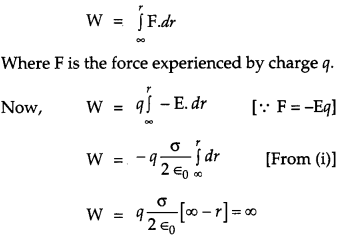
Question 8.
A device ‘X’ is connected to an ac source V = V0 sin ωt. The variation of voltage, current and power in one cycle is shown in the following graph: [5]
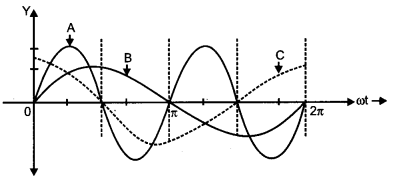
(a) Identify the device ‘X’.
(b) Which of the curves A, B and C represent the voltage, current and the power consumed in the circuit ? Justify your answer.
(c) How does its impedance vary with frequency of the ac source ? Show graphically.
(d) Obtain an expression for the current in the circuit and its phase relation with ac voltage.
OR
(a) Draw a labelled diagram of an ac generator. Obtain the expression for the emf induced in the rotating coil of N turns each of cross-sectional area A, in the presence of magnetic field B .
(b) A horizontal conducting rod 10 m long extending from east to west is falling with a speed 5.0 ms-1 at right angles to the horizontal component of the Earth’s magnetic field, 0. 3 x 10-4 Wb m2. Find the instantaneous value of the emf induced in the rod.
Answer:
(a)The device X is a capacitor.
(b) The curves A,B and C represents power consumption, voltage and current respectively. Since, it is given V = V0 sin ωt; this sinusoidal variation is represented by the curve B. In case of capacitor, current (I) leads the voltage by 90° which is being represented by curve C. Now, we know power is given by
P = V× I
So, the power would be positive for those cycles where both V and I are either positive or negative. Power would be negative when one of the two voltage or current, is negative. This illustration is followed by the curve A.
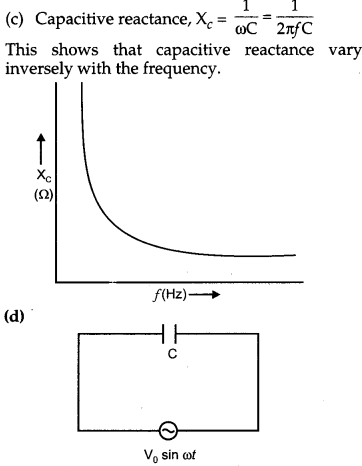
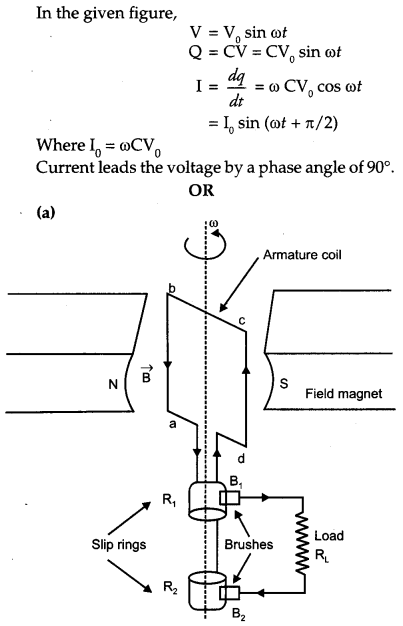
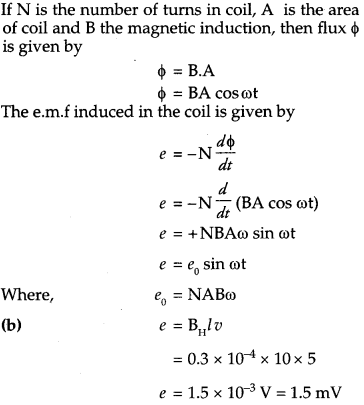
Question 9.
(a) Define wave front. Use Huygens’ principle to verify the laws of refraction.
(b) How is linearly polarised light obtained by the process of scattering of light ? Find the Brewster angle for air-glass interface, when the refractive index of glass = 1.5. [5]
OR
(a) Draw a ray diagram to show the image formation by a combination of two thin convex lenses in contact. Obtain the expression for the power of this combination in terms of the focal lengths of the lenses.
(b) A ray of light passing from air through an equilateral glass prism undergoes minimum deviation when the angle of incidence is 3/4th of the angle of prism. Calculate the speed of light in the prism
Answer :
(a) Wavefront : A wavefront is a continuous locus of all the particles of a medium which are vibrating in the same phase.
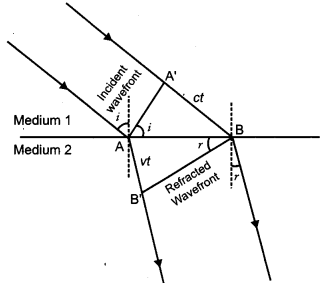
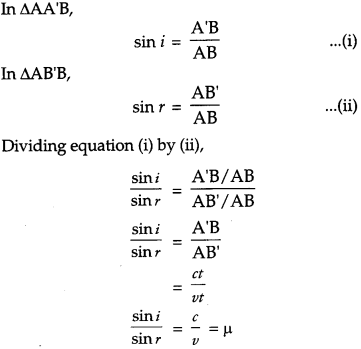
This is the snell’s law of refraction.
(b) When a beam of white light is passed through a medium containing particles whose size is of the order of wavelength of light, then the beam gets scattered. When the scattered light is viewed through an analyser in a direction at the right angle to the direction of incidence, it is found to be plane polarised. This is called polarization by scattering.
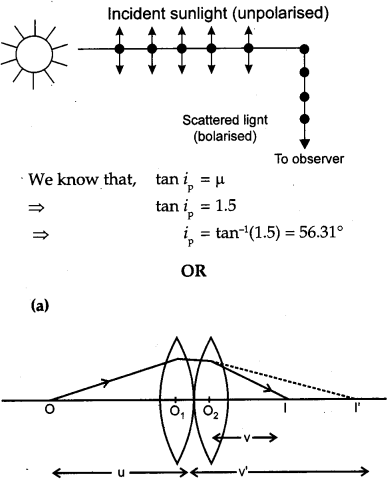
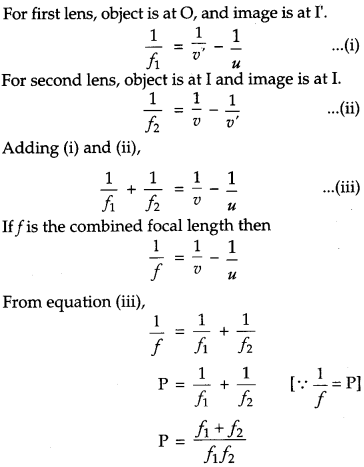
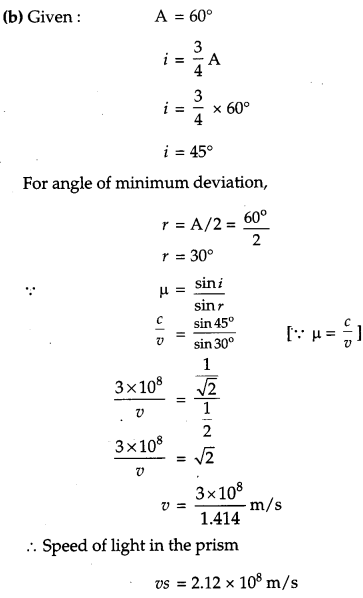
Question 10.
Nichrome and copper wires of same length and same radius are connected in series. Current I is passed through them. Which wire gets heated up more ? Justify your answer. [1]
Answer:
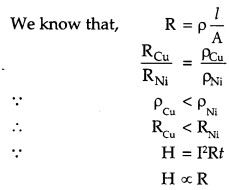
∴ Nichrome wire will get heated up more.
Question 11.
Do electromagnetic waves carry energy and momentum ? . [1]
Answer :
Yes, the electromagnetic waves carry energy and momentum because,

Question 12.
How does the angle of minimum deviation of a glass prism vary, if the incident violet light is replaced by red light ? Give reason. [1]


Question 13.
Name the phenomenon which shows the quantum nature of electromagnetic radiation. [1]
Answer:
Photoelectric effect.
Question 14.
Predict the polarity of the capacitor in the situation described below: [1]
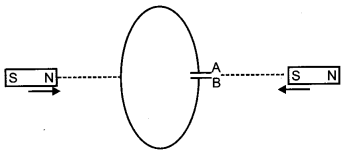
Answer:
A will be positive and B will be negative
Question 15.
(a) The potential difference applied across a given resistor is altered so that the heat produced per second increases by a factor of 9 By what factor does the applied potential difference change ?
(b) In the figure shown, an ammeter A and a resistor of 4 Ω are connected to the terminals of the source. The emf of the source is 12 V having the internal resistance of 2Ω . Calculate the voltmeter and ammeter readings. [3]
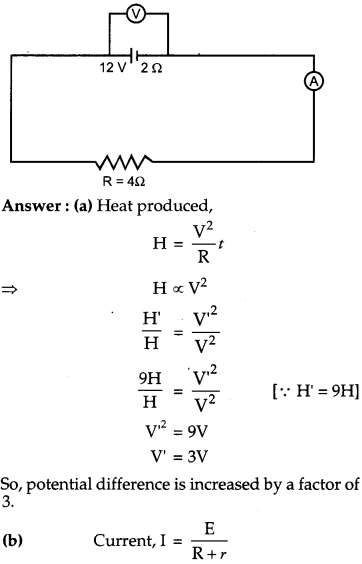
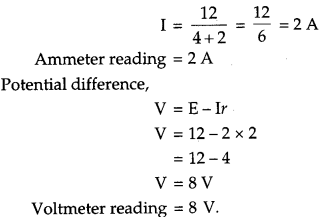
Question 16.
(a) How is amplitude modulation achieved ?
(b) The frequencies of two side bands in an AM wave are 640 kHz and 660 kHz respectively. Find the frequencies of carrier and modulating signal. What is the bandwidth required for amplitude modulation ? [3]
Question 17.
(a) In the following diagram, is the junction diode forward biased or reverse biased ?

(b) Draw the circuit diagram of a full wave rectifier and state how it works. [3]
Answer:
(a) Reverse biased.
(b) Full wave Rectifier:
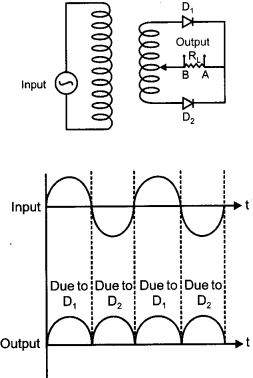
Diode D1 conducts only when the junction is forward biased. Hence during first half cycle of input A.C., D1 will conduct while D2 will not and current in RL will flow from A to B. Diode D2 is reverse biased. During second half cycle of input A.C., diode D2 will conduct while D1 will not conduct and current will again flow from A to B in Hence complete cycle will become unidirectional.
Question 18.
Using photon picture of light, show how Einstein’s photoelectric equation can be established. Write two features of photoelectric effect which cannot be explained by wave theory. [3]
Answer :
Einstein’s photoelectric equation : Einstein explained the various laws of photo¬electric emission on the basis of Planck’s quantum theory. According to Planck’s quantum theory, light radiations consist of tiny packets of energy called quanta. One quantum of light radiation is called a photon which travels with the speed of light.
The energy of a photon is given by,
E=hv
where h is Planck’s constant and u is the frequency of light radiation. Einstein assumed that one photo electron is ejected from a metal surface if one photon of suitable light radiation falls on it. Consider a photon of light of frequency u, incident on a photosensitive metal surface. The energy of the photon (= hv) is spent in two ways :
(a) A part of the energy of the photon is used in liberating the electron from the metal surface which is equal to the work function Φ0 of the metal.
(b) The rest of the energy of the photon is used in imparting the kinetic energy to the emitted photo electron. If Vmax is the maximum velocity of the emitted photoelectron and m is its mass, then
Max. K.E. of the photoelectron,

This equation is called Einstein’s photoelectric equation.
Features of photoelectric effect which can not be explained by wave theory:
1. The wave theory could not explain the instantaneous process of photoelectric effect.
2. Maximum fcinetic energy’ of the emitted photoetectrous is independent of intensity of incident light.
Question 19.
(a) Monochromatic light of wavelength 589 run is incident from air on a water surface. If μ for water is 1.33, find the wavelength, frequency and speed of the refracted light,
(b) A double convex lens is made of a glass of refractive index 1.55, with both faces of the same radius of curvature. Find the radius of curvature required, if the focal length is 20 cm. [3]
Answer:
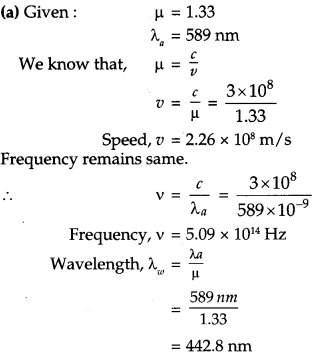
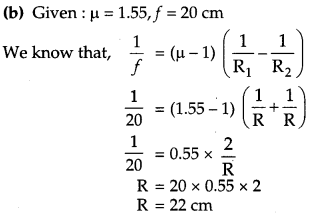
Question 20.
Define mutual inductance between a pair of coils. Derive an expression for the mutual inductance of two long coaxial solenoids of same length wound one over the other. [3]
OR
Define self-inductance of a coil. Obtain the expression for the energy stored in an inductor L connected across a source of emf.
Answer:
Mutual inductance is numerically equal to the induced e.m.f in the secondary coil when the current in the primary coil changes by unity. Suppose two long co-axial solenoids each of length l. We denote the area of the inner solenoid S1 by A1 and the number of turns per unit length by n1 The corresponding quantities for the outer solenoid S2 are A2 and n2 respectively. Let and N2 be the total number of turns of coils S1 and S2 respectively.
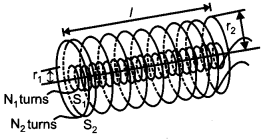
When a current I2 is set up through S2, it in turn sets up a magnetic flux through S1 Let us denote it by Φ1.
The magnetic field due to current I1 in S1 is given by
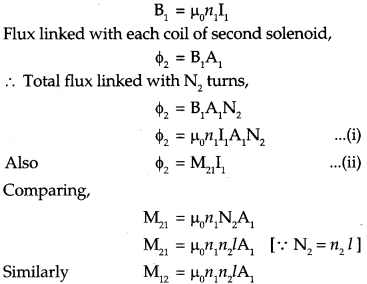
OR
Self inductance : Self inductance of a coil is equal to the magnitude of induced emf produced in the coil when rate of change of current through the coil is unity.
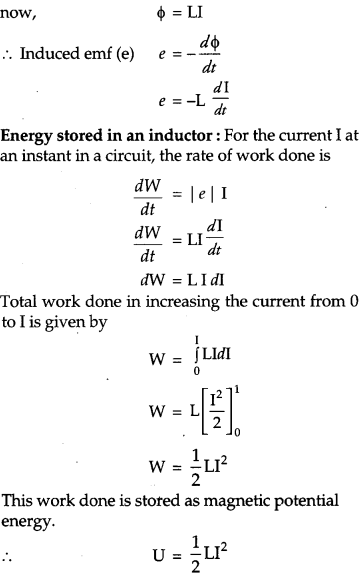
Question 21.
(a) Write the principle of working of a meter bridge.
(b) In a meter bridge, the balance point is found at a distance I1 with resistances R and S as shown in the figure.
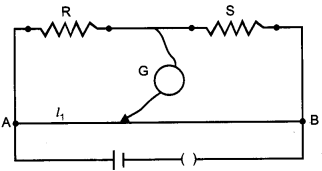
An unknown resistance X is now connected in parallel to the resistance S and the balance point is found at a distance I2 . Obtain a formula for X in terms of I2 , I2 and S. [3]
Answer :
(a) Meter bridge works on the principle of balanced Wheatstone bridge i.e., when the bridge is balanced,
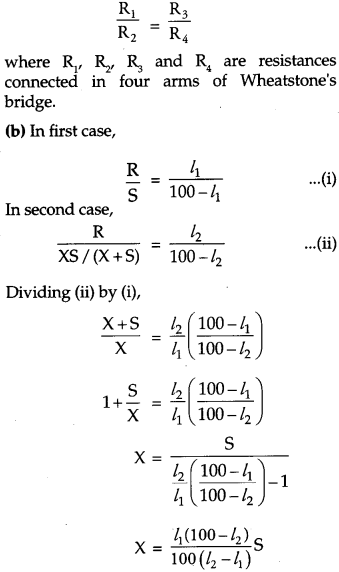
Question 22.
Draw a block diagram of a generalized communication system. Write the functions of each of the following : [3]
(a) Transmitter
(b) Channel
(c) Receiver
Question 23.
(a) Write the functions of the three segments of a transistor.
(b) The figure shows the input wave forms A and B for ‘AND’ gate. Draw the output waveform and write the truth table for this logic gate. [3]
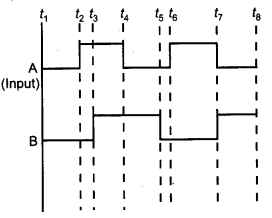
Question 24.
(a) Draw a ray diagram depicting the formation of the image by an astronomical telescope in normal adjustment.
(b) You are given the following three lenses. Which two lenses will you use as an eyepiece and as an objective to construct an astronomical telescope ? Give reason. [3]
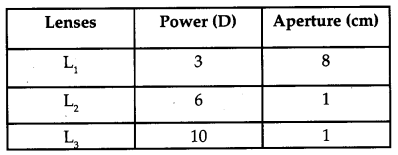
Answer:
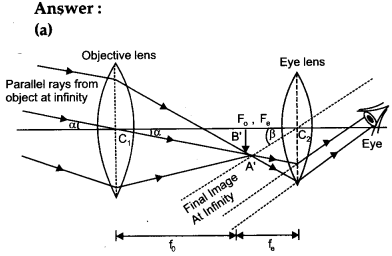
(b) An astronomical telescope should have an objective of large aperture and longer focal length while an eyepiece of small aperture and small focal length. Therefore, we will use L1 as an objective and L3 as an eyepiece.
Question 25.
(a) State Biot-Savart law and express this law in the vector form.
(b) Two identical circular coils, P and Q each of radius R, carrying currents 1 A and √3 A respectively, are placed concentrically and perpendicular to each other lying in the XY and YZ planes. Find the magnitude and direction of the net magnetic field at the centre of the coils. [3]
Answer:
(a) Biot-Savart Law :
It states that the magnetic field strength (dB) produced due to a current element I and length dl at a point having position vector r⃗ relative to current element is
(i) directly proportional to the current I i.e., dB ∝ I
(ii) directly proportional to the length dl of the element i.e., dB ∝ dl.
(iii) directly proportional to sin θ, where θ is the angle between dl and r, i.e., dB ∝ sin θ .
(iv) inversely proportional to the square of the distance r from the current element i.e., dB ∝ 1/r2
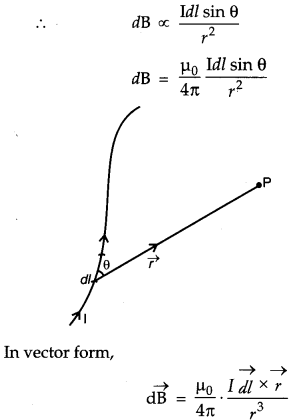
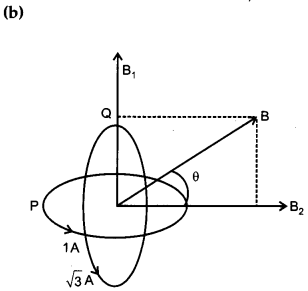
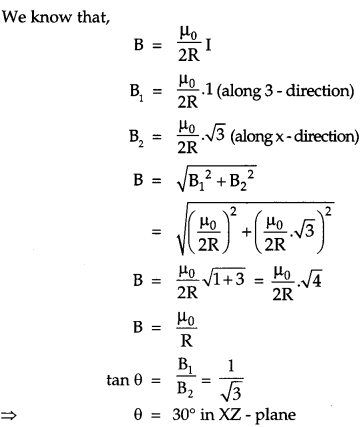
Question 26.
Two identical parallel plate capacitors A and B are connected to battery of V volts with the switch S closed. The switch is now opened and the free space between the plates of the capacitors is filled with a dielectric of dielectric constant K. Find the ratio of the total electrostatic energy stored in both capacitors before and after the introduction of the dielectric. [3]
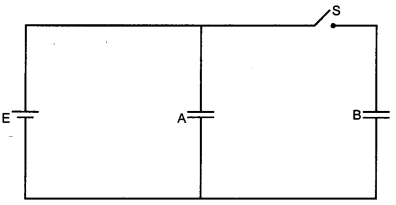
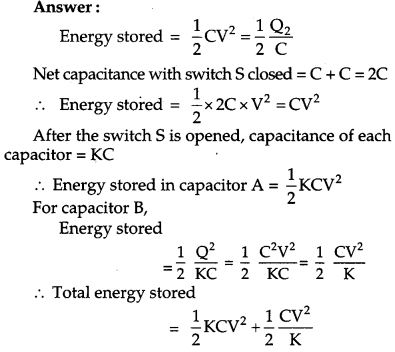
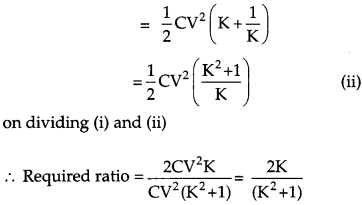
Class 12 Physics Previous Year Question Papers CBSE QNA
Q. Where I can get CBSE Class 12th Physics Previous Year Question Papers?
You can get CBSE Class 12 Physics Previous Year Question Papers on this page. We have given solved CBSE Class 12 Physics Previous Year Question Papers on this page.
Q. Are CBSE Class 12 Physics Previous Year Question Papers helpful to get good marks?
Yes, CBSE Class 12 Physics Previous Year Question Papers are very helpful to get good marks in the CBSE Term 2 Examination. The students must solve all the CBSE Class 12 Physics Previous Year Question Papers to pass CBSE Class 12th Term 2 Exam 2022 with flying colours.
Q. Which website is best for previous year’s question papers of CBSE Class 12th?

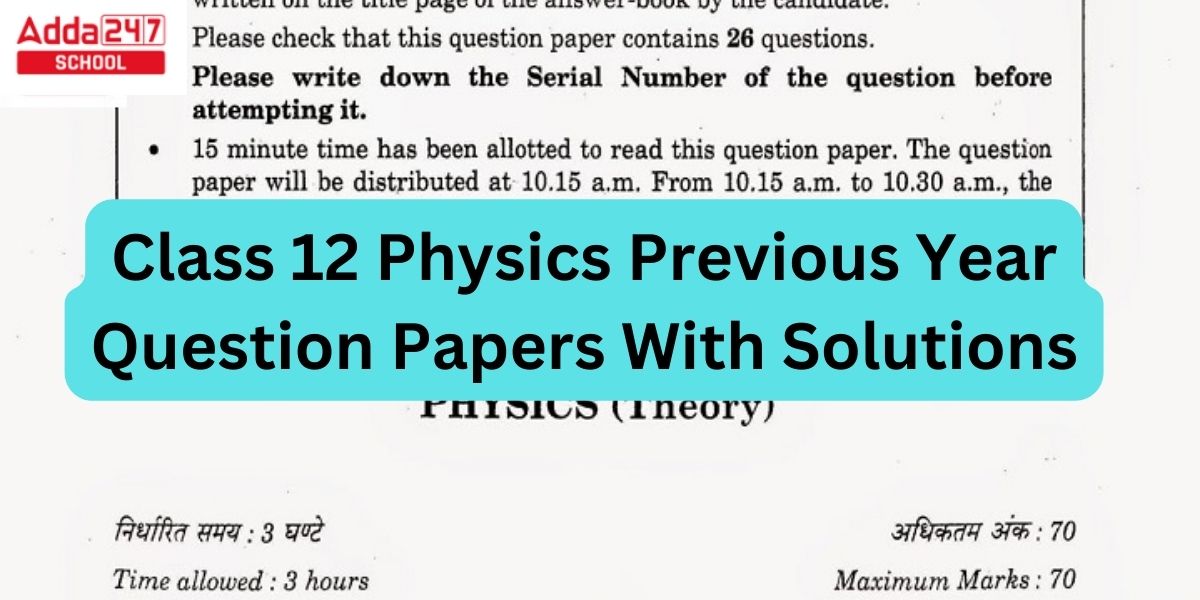










 CBSE Admit Card 2026 for Private & R...
CBSE Admit Card 2026 for Private & R...
 AILET 2026 AIR 1: Check Full Toppers Lis...
AILET 2026 AIR 1: Check Full Toppers Lis...
 AILET Result 2026 OUT, How to Download S...
AILET Result 2026 OUT, How to Download S...






